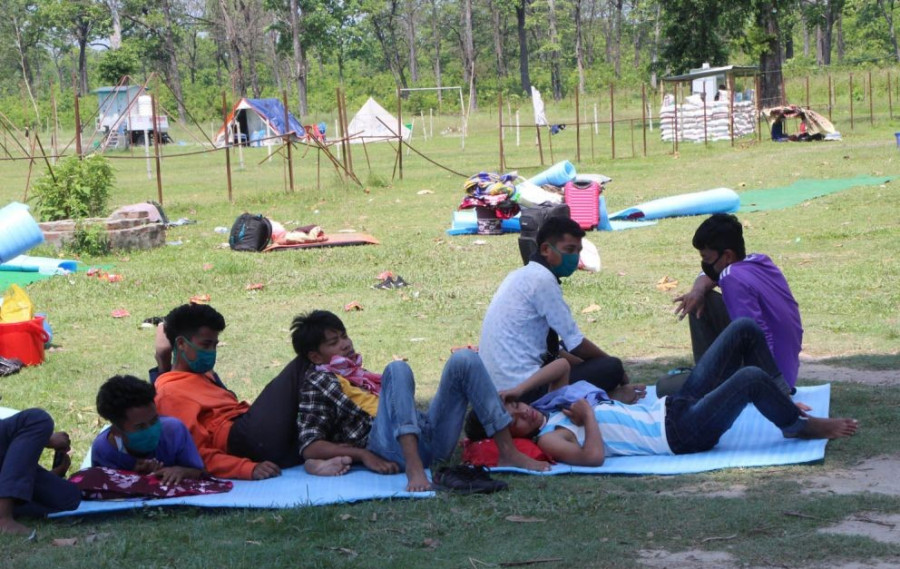Health
Rising Covid-19 cases and limited isolation beds once again expose government’s lack of preparedness to fight the virus
Amid plans to send infected persons home and to poorly managed quarantine, experts warn of community spread.
Arjun Poudel
Nepal on Saturday reported 189 new Covid-19 cases, the highest for a single day, as the total number of coronavirus cases in the country rose to 1,401. Saturday’s increase marks the fourth consecutive day of more than 100 cases. With the sudden spike in the number of Covid-19 cases, there are now concerns that it’s just a matter of a couple of days that the hospitals designated for Covid-19 treatment will run out of isolation beds.
The government has designated 97 hospitals as Covid-19 treatment facilities and allocated 1,624 isolation beds.
Most of the hospitals in Covid-19 hotspots—Biratnagar, Birgunj, Butwal and Nepalgunj—are already overwhelmed. With 219 patients discharged as of now, there are now just 442 isolation beds available for new patients across the country.
Health Ministry officials conceded that there won’t be any isolation beds in the next few days, given the rate of rise in Covid cases.
According to an official, by arranging a few hundred more beds, the maximum number of Covid-19 patients the hospitals can adjust will be somewhere between 1,500 and 2,000.
Dr Bikash Devkota, spokesperson for the Health Ministry, said Covid-19 patients will be sent to quarantine facilities set up at schools and public buildings, like in Birgunj and Nepalgunj.
“They will be monitored there by trained health workers,” said Devkota. “We will then ask asymptomatic patients to go home.”
But given the already overwhelmed quarantine facilities and poor management, experts have warned against taking such a move, as it could lead to a catastrophe.
Currently, over 110,000 people are being quarantined in facilities across the country, with some housing around 1,000 while their capacity to accommodate is just around 100.
And even if the asymptomatic patients are sent home, there are chances of the virus spreading in the family and the community.
"In a country like ours, where a majority of people use a single toilet, share beds and live in small congested rooms, chances of transmission of the disease in the family and then the community are high,” Dr Baburam Marasini, former director at the Epidemiology and Disease Control Division, told the Post. “Only those who can ensure self-quarantine can be sent home.”
Marasini said that this situation, however, was imminent.
“The Health Ministry briefings have become a ritual where they have been simply counting the number of patients and tests. The government completely failed to utilise the lockdown period to prepare for the situation we are in today,” said Marasini. “All the available isolation beds were allocated before the lockdown started. The government has not increased the number of isolation beds in the last two months.”
The government’s poor handling of the disease was evident since the early days when the country had reported only a couple of positive cases. Even as countries across the world confirmed a rise in the number of cases and deaths, government ministers were claiming that Nepal was a Covid-19-free country.
When the cases started to gradually rise, the government was embroiled in a controversy over the purchase of medical equipment. The government was so unprepared that even those working on the frontlines lacked basic amenities like masks and personal protective equipment. The rapid diagnostic kits that were imported from China could not be used for days as there were concerns over efficacy.
It was only in late March, when two cases were reported, that the government announced a lockdown, which on Saturday entered its 68th day.
“The Health Ministry wasted precious time given by the lockdown to upgrade and increase facilities,” said Marasini.
Bagmati Province, which has reported fewer cases (45) until now, has 473 isolation beds, the largest number in the country. Meanwhile, Province 2, which is severely affected with 547 cases—over one third of the total cases, has only 140 isolation beds. There are 210 isolation beds in Province 5 with 547 cases, with Kapilvastu reporting 269 cases, second highest for a district.
"Yes, we have encountered a big problem,” conceded Devkota, the Health Ministry spokesperson. "Now we don’t have any other option than to send infected people home if they cannot be adjusted at quarantine facilities.”
Authorities, however, are yet to ascertain which quarantine facilities are to be used for keeping the infected persons. Devkota admitted delay in preparations. “A decision on the next move is yet to be taken,” said Devkota.
Dr Roshan Pokhrel, chief specialist at the Health Ministry, said that the authorities are aware of the fact that sending infected people home raises the risk of virus transmission.
“The risk level has gone up with the rise in the number of cases,” Pokhrel told the Post. “But we have limited options. Most of the countries have asked asymptomatic patients to stay home, and we too will follow the same protocol."
Marasini, however, said Nepal cannot afford to simply follow what other countries are doing, as the situation is completely different here.
“There is no other way than expanding isolation facilities. Hotels, schools and college buildings can be used, and the government should immediately start converting them into isolation facilities," said Marasini. "Otherwise, the disease can spread in the wider community. If that happens, it will be very difficult to contain the disease."




 5.55°C Kathmandu
5.55°C Kathmandu














